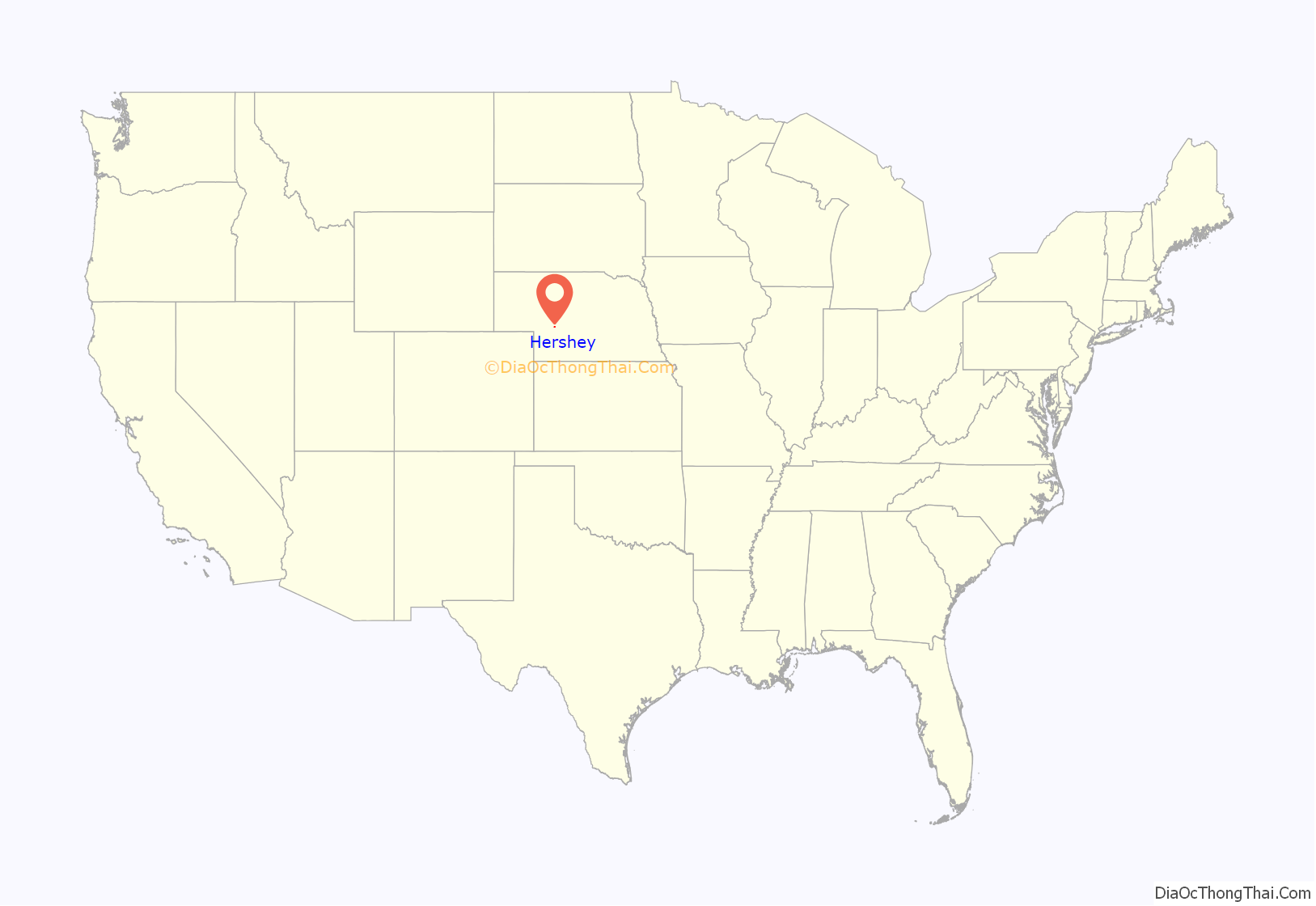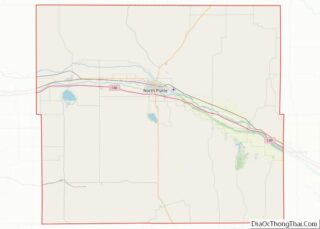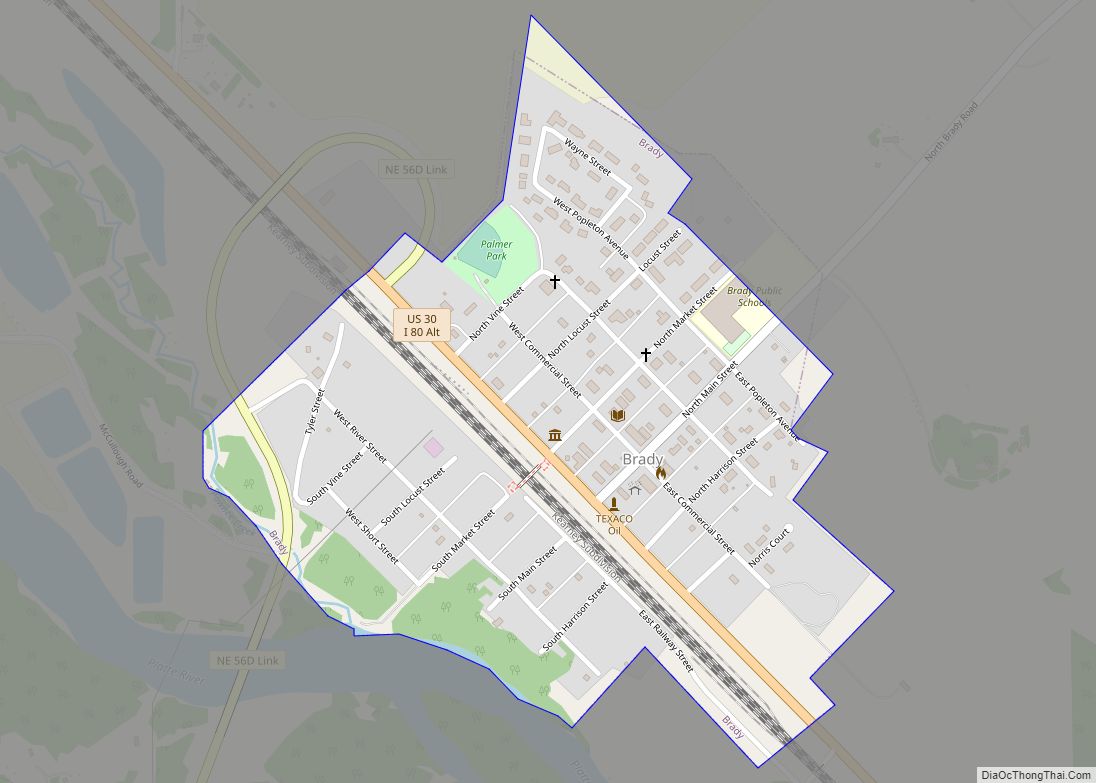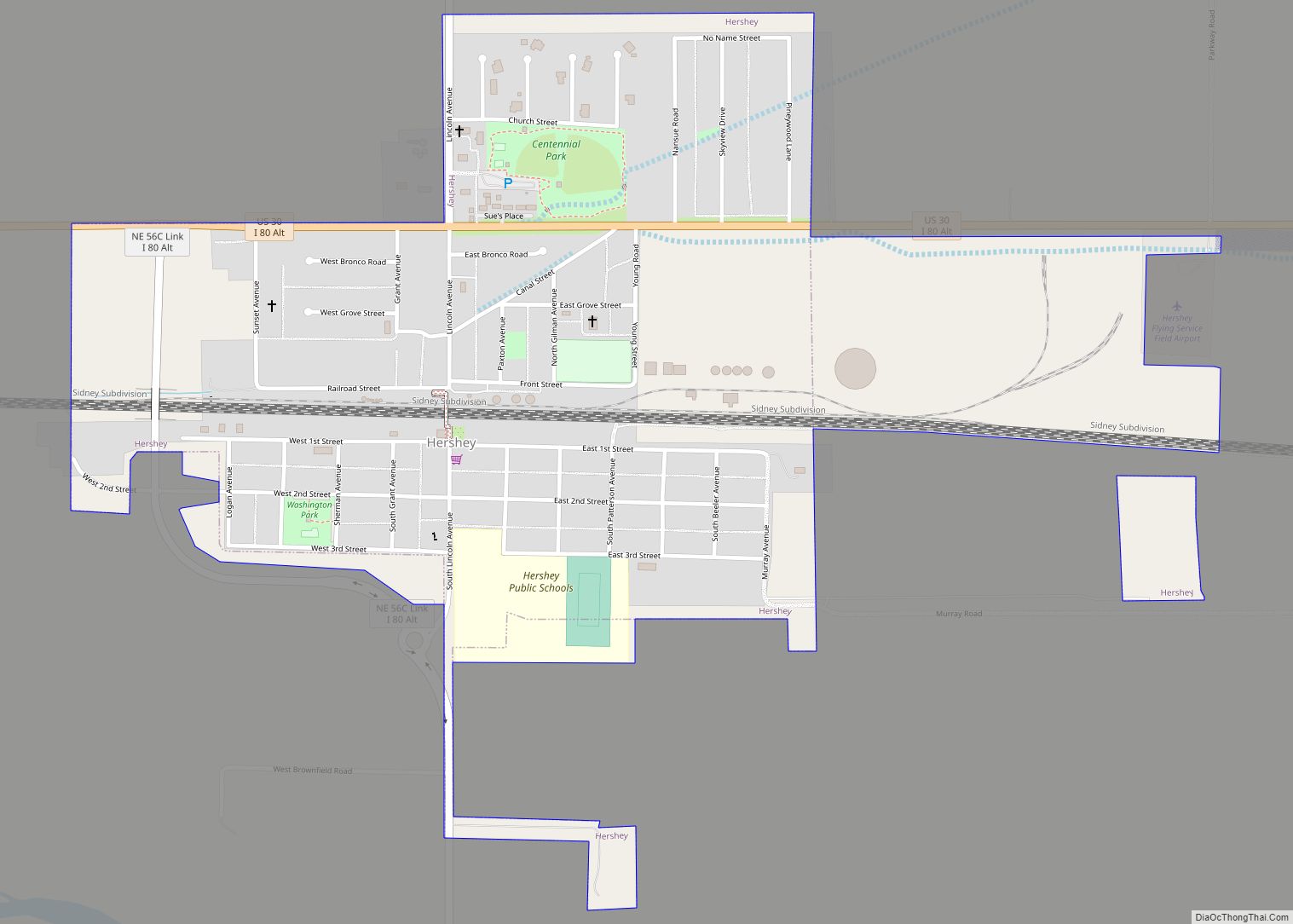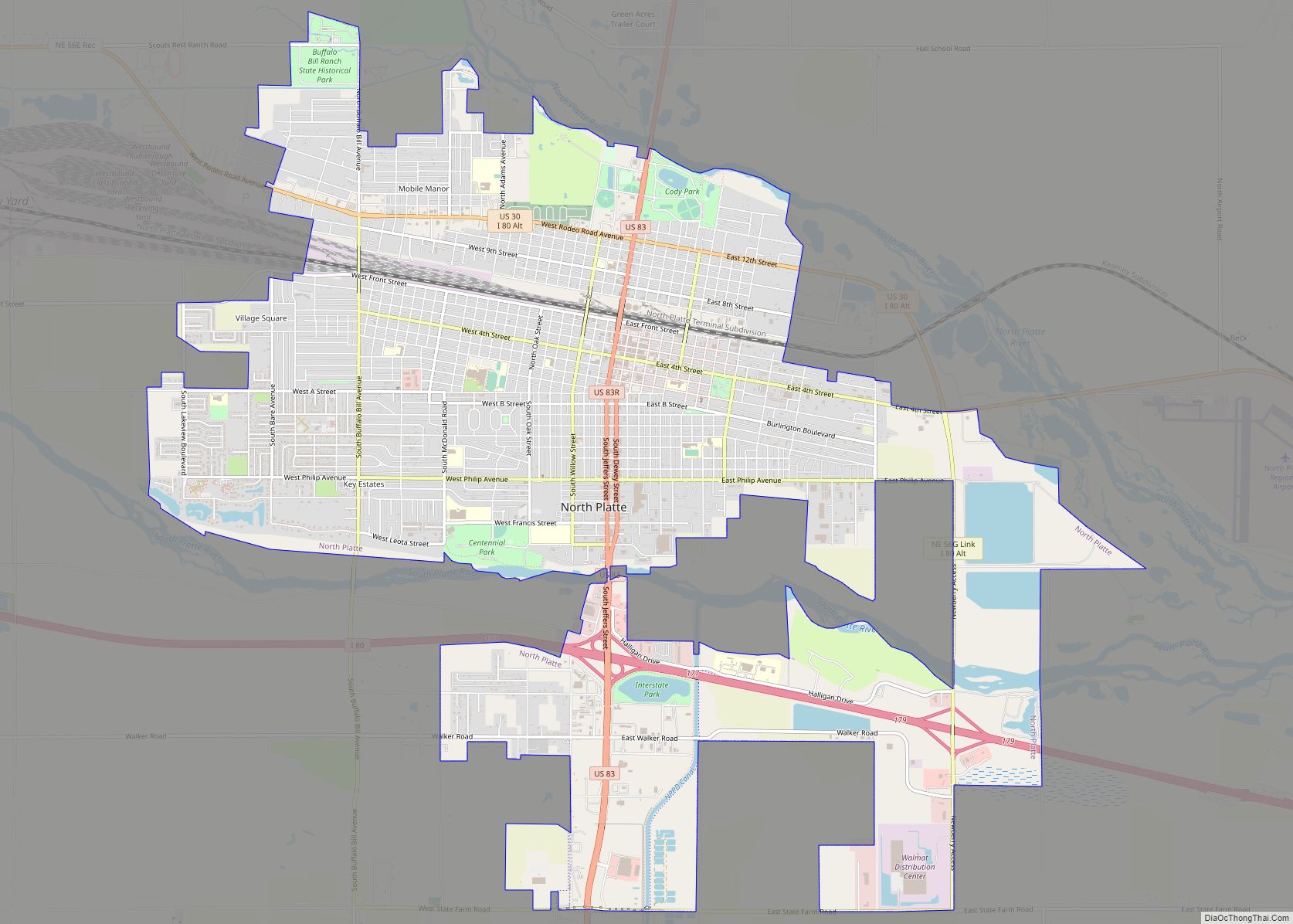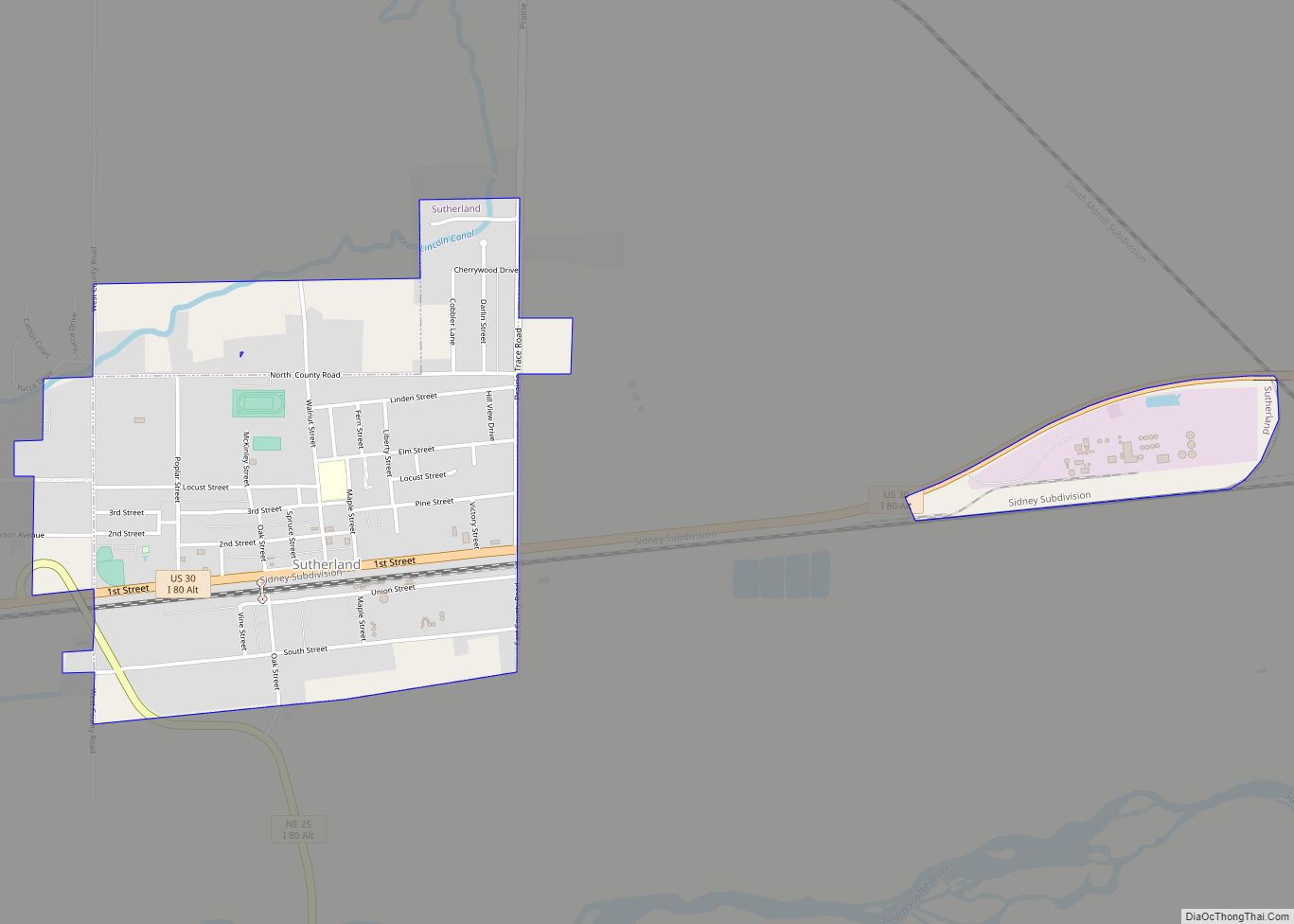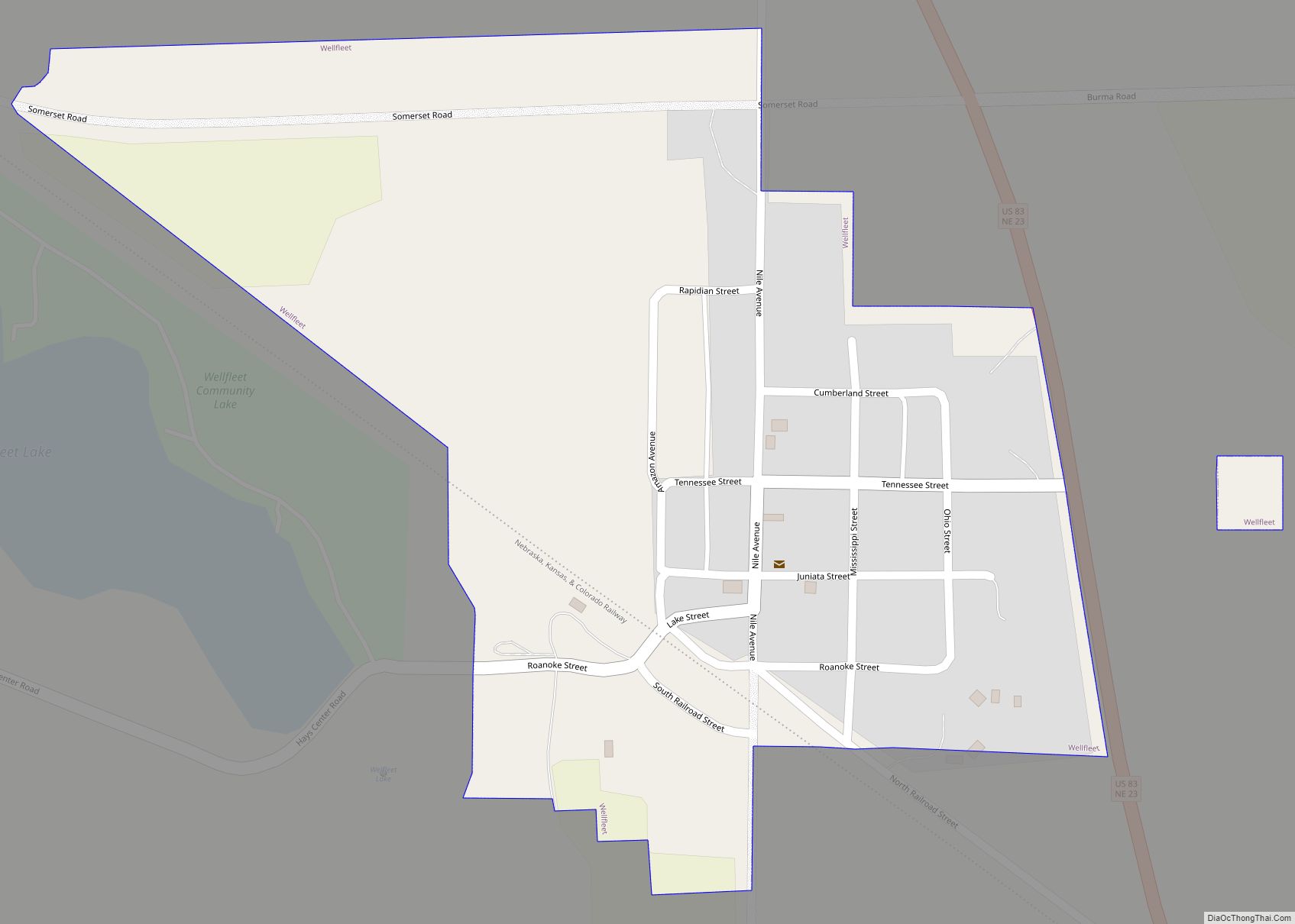Hershey is a village in Lincoln County, Nebraska, United States. It is part of the North Platte, Nebraska Micropolitan Statistical Area. The population was 665 at the 2010 census.
| Name: | Hershey village |
|---|---|
| LSAD Code: | 47 |
| LSAD Description: | village (suffix) |
| State: | Nebraska |
| County: | Lincoln County |
| Elevation: | 2,900 ft (884 m) |
| Total Area: | 0.76 sq mi (1.98 km²) |
| Land Area: | 0.76 sq mi (1.98 km²) |
| Water Area: | 0.00 sq mi (0.00 km²) |
| Total Population: | 649 |
| Population Density: | 850.59/sq mi (328.30/km²) |
| ZIP code: | 69143 |
| Area code: | 308 |
| FIPS code: | 3122290 |
| GNISfeature ID: | 0829938 |
Online Interactive Map
Click on ![]() to view map in "full screen" mode.
to view map in "full screen" mode.
Hershey location map. Where is Hershey village?
History
Beginnings
Hershey was established as a station on the Union Pacific Railroad. It was named for J. H. Hershey, a pioneer settler. The locations of the pre-existing O’Fallon’s and Nichol’s Stations are shown on an 1884 map of Lincoln County. An 1894 map shows the Hershey Station, to the west of Nichol’s Station. The original town–consisting of 24 lots laid out in two square blocks–was platted on February 5, 1892 by Annie S. Guthrie.
Hershey in 1900
By 1900, Hershey had about 20 resident families and a population of 80. This included a blacksmith (Alfred Leister), two merchants (Joseph Strickler and Martin Mickelsen), a lumberman (Weston Hill), a liveryman (Horace Stone), a doctor (William Eves), a postmaster (John Pricket), a minister (William Evans), and two railroad foremen. There were about 64 farm families (including laborers working for others) in the surrounding Nichols Precinct. Most families were of American origin, although there were five German families, and one or two each of Swedish, French, Scottish, Dutch, Bohemian and Canadian background. The village was incorporated in April 1909.
From 1900 to 1920
Between 1900 and 1920, Hershey grew rapidly and added the structural foundation, commercial attractions, and social amenities of an important economic center for the surrounding area. A local newspaper, the Hershey Times, began publication in 1911. In 1913, a bond issue was approved providing for public water and electric lights. A telephone exchange was introduced in 1914. Businesses in Hershey in 1920, in addition to those present in 1900, included two mills (one of which, an alfalfa mill, burned in March 1920), two elevators, a hotel, two banks, three agricultural implement dealers, a cement works, an automobile dealer, a garage, a tire store, a meat market, a drug store, a restaurant, a number of dealers in agricultural products, including stock and hay, a barber, and an Opera House. There were three churches, the Methodist, Presbyterian (54 members), and Lutheran (40 members), and a number of fraternal organizations, including the Odd Fellows (63 members), Yeomanry (39 members), Modern Woodmen of the World, Royal Neighbors and Mystic Legion.
Agricultural Context
Hershey is located between the North and South Platte rivers in the midst of good agricultural land, much of it irrigated. From an early date, agricultural production emphasized stock raising, alfalfa, and sugar beets. The sugar beet industry was encouraged by a tariff on sugar enacted in 1897. In 1905, there were 721 acres in Nicols Precinct planted to sugar beets. Shipments from Hershey in 1919 included 904 rail carloads of hay and 279 carloads of sugar beets. While the sugar content of the beets raised near Hershey was high, the volume was long insufficient to support a processing plant.
Additional Immigrant Groups
Both the railroad and the sugar beet industries were labor intensive, attracting additional immigrant groups to supply that labor. These groups included Russian Germans (ethnic Germans from Russia), Japanese and Mexicans. In 1900, there were three Russian families in the Hershey area (Henry Haff, George Amen, and Conrad Amen), two of whom had become farmers in their own right. By 1910, there had been a substantial influx of Swedish settlers, most engaged in farming. There were also two households of Japanese men in Nichols Precinct, without wives, one consisting of seven men working for the railroad and one of four men engaged in farming. By 1920, there were eight Japanese families in Hershey itself, all engaged in farming. The Mexican community repeated the pattern: in 1920, there were three Mexican households in Hershey, including young men working for the railroad. By the late 1920s, there were 19 Mexican families in Hershey. Both the Japanese and Mexican families were important parts of the community thereafter.
Hershey Road Map
Hershey city Satellite Map
Geography
Hershey is located on the Union Pacific Railroad’s Overland Route at 41°9′29″N 101°0′6″W / 41.15806°N 101.00167°W / 41.15806; -101.00167 (41.158118, -101.001721).
According to the United States Census Bureau, the village has a total area of 0.61 square miles (1.58 km), all land.
Climate
See also
Map of Nebraska State and its subdivision:- Adams
- Antelope
- Arthur
- Banner
- Blaine
- Boone
- Box Butte
- Boyd
- Brown
- Buffalo
- Burt
- Butler
- Cass
- Cedar
- Chase
- Cherry
- Cheyenne
- Clay
- Colfax
- Cuming
- Custer
- Dakota
- Dawes
- Dawson
- Deuel
- Dixon
- Dodge
- Douglas
- Dundy
- Fillmore
- Franklin
- Frontier
- Furnas
- Gage
- Garden
- Garfield
- Gosper
- Grant
- Greeley
- Hall
- Hamilton
- Harlan
- Hayes
- Hitchcock
- Holt
- Hooker
- Howard
- Jefferson
- Johnson
- Kearney
- Keith
- Keya Paha
- Kimball
- Knox
- Lancaster
- Lincoln
- Logan
- Loup
- Madison
- McPherson
- Merrick
- Morrill
- Nance
- Nemaha
- Nuckolls
- Otoe
- Pawnee
- Perkins
- Phelps
- Pierce
- Platte
- Polk
- Red Willow
- Richardson
- Rock
- Saline
- Sarpy
- Saunders
- Scotts Bluff
- Seward
- Sheridan
- Sherman
- Sioux
- Stanton
- Thayer
- Thomas
- Thurston
- Valley
- Washington
- Wayne
- Webster
- Wheeler
- York
- Alabama
- Alaska
- Arizona
- Arkansas
- California
- Colorado
- Connecticut
- Delaware
- District of Columbia
- Florida
- Georgia
- Hawaii
- Idaho
- Illinois
- Indiana
- Iowa
- Kansas
- Kentucky
- Louisiana
- Maine
- Maryland
- Massachusetts
- Michigan
- Minnesota
- Mississippi
- Missouri
- Montana
- Nebraska
- Nevada
- New Hampshire
- New Jersey
- New Mexico
- New York
- North Carolina
- North Dakota
- Ohio
- Oklahoma
- Oregon
- Pennsylvania
- Rhode Island
- South Carolina
- South Dakota
- Tennessee
- Texas
- Utah
- Vermont
- Virginia
- Washington
- West Virginia
- Wisconsin
- Wyoming
